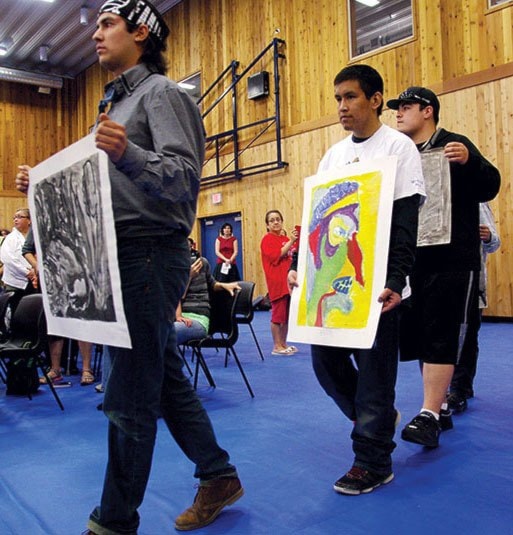It took a long time for Georgina Cootes to get used to art teacher Robert Aller, a volunteer who worked with students of the Alberni Indian Residential School from 1959 to 1966. It took a long time not to be afraid that he would do to her what other adults had done to her in the school, she said.
“But he didn’t.”
Aller instead provided a safe space for Cootes and other First Nations children from AIRS to create; to see something in their mind’s eye and put it down with paint on paper without fear of reprisal.
And what they created were scenes of home, of their culture, of a way of life far from a notorious place that would become synonymous with physical, mental, emotional and sexual abuse perpetrated against Indian children.
Cootes painted a picture of the beach at her home in Kildonan. She explained that she deliberately chose not to include the houses there, because their absence represented the children taken from home to attend residential school.
On March 30, Cootes was reunited with her painting in an emotional repatriation ceremony that took place at Alberni Athletic Hall. The family of Robert Aller, who died in 2008, were in attendance to witness the event.
(In addition to his work at AIRS, Aller studied with Group of Seven painter Arthur Lismer and in 1965 helped form the Community Arts Council of the Alberni Valley with Tseshaht artist George Clutesi and others.)
Art teacher Aller had asked each child for a painting that he could keep, and after his death, the collection of 47 paintings went to the University of Victoria.
For the past two years, UVic visual anthropologist Dr. Andrea Walsh has worked to find the artists to reconnect them with their art.
The original paintings were carried into the hall behind Nuu-chah-nulth drummers and set beside framed copies. The copies were presented to the artists and it was up to each of them to either take the original as well, or ask the university to continue to care for it.
Maquinna Lewis George, head chief of Ahousaht, the largest First Nation on the west coast of Vancouver Island, asked UVic to hold on to his paintings—one of a Halloween pumpkin and one of his father’s fishing boat.
“The best time of my life was fishing with my dad,” he said.
The paintings are to “come home” if the Nuu-chah-nulth ever build a museum or cultural centre of their own, Maquinna said through speaker Ron Hamilton.
And there was another proviso. His story was to accompany his paintings wherever they are stored—on this Maquinna was adamant.
“It’s critically important to him that along with those paintings goes his story—unchanged—in his words, not prettied up in any way,” Hamilton explained.
Maquinna remembered being very excited about the art class, because it got him away from the school and the early bedtime of six o’clock. He remembered the difficult time that the students had at AIRS and he choked up at the memories the paintings brought back.
He had never told his story publicly. He wasn’t done with his healing, he said, but he wanted to share.
When he was about six years old he got up early one morning to use the bathroom. A supervisor decided to teach the child a lesson about school rules. Maquinna said the supervisor told him to never, ever go to the bathroom again without his permission.
“He said ‘pull down your pajamas,’ and he strapped me. That’s the story that goes with (his paintings)... When you want to go and use the washroom, nobody should say you can’t,” said Maquinna.
Jeff Cook, a ranked chief with Huu-ay-aht First Nation, was the first to receive his framed print, choosing to leave his original painting of a black duck with Walsh. So important is the painting to the chief that he intends to reproduce it on his curtain, a ceremonial draping that shows the history of his people.
Cook said there is little that remains from that time in his life. He said he became very emotional to have something from his youth.
Charlie Max Lincoln of Kincolith in Nisga’a territory dressed in his traditional regalia for the re-uniting ceremony. His picture was coloured with rockets heading to the moon, an eagle soaring and the boat of his father.
“When I first saw it, my heart nearly stopped,” he said. Aller had told him to ‘draw whatever your heart feels.’
The art classes allowed the children to remember the people they came from; unlike the school environment where children were strapped for speaking or singing in their traditional languages, he said.
Lincoln also took time to thank a Miss Joseph who worked in the kitchen at AIRS. “She was our mother,” he said. Joseph provided protection, some extra food from time to time and hugs when they were needed, Lincoln explained. She always told him to be proud of where he came from.
Shelley Chester never knew her mom, Phyllis Tate, who gave her up for adoption. Still, seeing her mother’s paintings was an emotional experience. Chester choked up when declaring she didn’t know what she wanted to do with the originals.
“To touch something that she created is really something,” Chester said.
Myrna Cranmer said it’s been 41 years since she left residential school. She understood the label survivor, she said. “I get it, but I prefer warrior.” The school, she explained, made her tough.
The artwork was first displayed at the Truth and Reconciliation regional event in Victoria last April. The works left with the university can be seen in an upcoming exhibit at UVic’s Legacy Art Gallery located at 630 Yates St. starting May 8.
* Debora Steel is editor of Ha-Shilth-Sa, the Nuu-chah-nulth Tribal Council’s newspaper.
